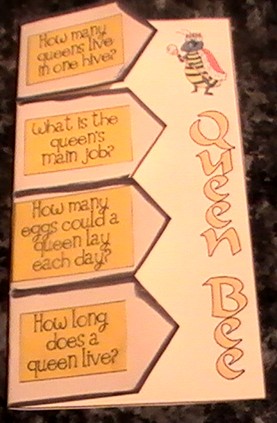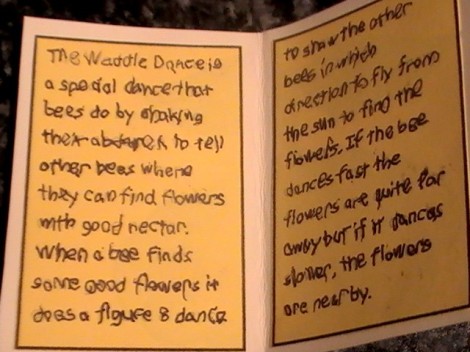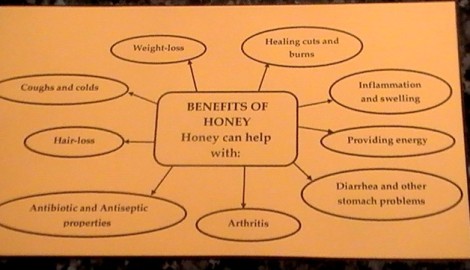This was one of the largest and most detailed projects I have ever worked on with my kids and I also learned so much along the way, masha’Allah. The Honey Bee is the most fascinating creature and is truly a blessed creation. I can’t take full credit for this project because it was actually emailed to me in a Lapbook format from an absolutely wonderful list I’m on dedicated to Lapbooking. Anyone interested in Lapbook or wanting to know more would benefit from signing up here insha’Allah. This list is set up to coincide with the Islamic Lapbooking Blog which is an absolute must-see for anyone addicted to Lapbooking.
The above photo doesn’t do true justice to the scale of this piece of work. It is two A1 sheets taped together. It was so large and so heavy that even a combination of blu-tac and drawing pins couldn’t keep this on the wall for more than 24 hours at a time! Eventually it came down from the wall and is being kept in safe storage until we can take it apart carefully and put it together into a lapbook form.
With a whole chapter of the Qur’an (Surah An-Nahl) named after this amazing creature, it was the focal point of the project to look at the ayat (verses) which mention the honey bee. We read the verses and then discussed the meaning of it and I asked the kids what they thought the verses meant in their own words, and by the end of this project they were amazed that these two short verses were so precise and detailed enough to show that Allah is the Creator of amazing things, subhan’Allah!!
We put together a set of about 10 vocabulary cards. I googled for some images to add to the vocabulary cards to help the kids understand a little better what we were talking about, and as I said before, I learned quite a bit too from the very beginning! There was a nice template of a pocket to fit our vocab cards into. Alot of the stuff I printed onto various shades of yellow card for obvious reasons ;D
We made some hexagonal cells from cardboard and then filled them with scrunched up golden tissue paper to make them look like honey-filled cells.
I’m sure many of you will have seen something like this before. This shows the four stages of the life of the honey bee. From the egg through to the adult stage. Turn the wheel to see the different stages.We also watched a great time lapse video on the development and growth of the honey bee here.
Then we learned a bit more about the Queen Bee herself and put together this simple question and answer flap book. The questions were pasted onto the front of the flaps and the answers were researched and then written inside. We found a lot of information on the Queen Bee here.
Another little flap book with a few more details on the Queen Bee.
A diagram on the Honey Bee anatomy coloured and labeled by my son. I got him to do a bit of research himself in a book called ‘Ants, Bees and Wasps’ and he was able to use the info from there to complete the diagram labels.
Next we did a bit of research into Drones. These are the male honey bees who fertilise the Queen bees eggs. There are only about 10-15 drones in one hive and their sole job is mate with the Queen. We made a little hexagonal-shaped flap with some info on Drones.
The flap template was actually quite small considering all the information we wanted to include, so I decided it would be a good opportunity to let my son brush up on his IT skills. So he sat and typed up the information into hexagonal boxes which we then printed, cut out and pasted onto the flaps. We found lots of information about Drones here and we found this video very useful too, masha’Allah (although I would advice caution if visiting the website of Harun Yahya, Allahu alem)
The Waddle Dance (sometimes known as the Waggle Dance) is a very interesting phenomenon of the Honey Bee, masha’Allah. I knew next to nothing about this until we watched this informative video. We watched the video a few times and then I got the kids to tell me in their own words what they understood about it. Then my son wrote inside the little book to explain what he understood about the Waddle Dance, what it is and why the bees do it.
The term “busy bee” is no joke! The Worker honey bee has an almost never-ending list of jobs to do as you can see from the photos above. All the worker bees are non-reproducing females and they work almost non-stop until they die. On average, the worker bees live for about 6 weeks in the Summer and 4 months in the winter. The reason they live longer in the winter is because they are not collecting nectar or pollen during this time.
We really enjoyed doing the research to make this little T-book on what bees do for us and what they give us. Again, the template was very small so after talking about this subject I typed up these little flaps, printed them and folded them.
Next we made a list of all the Honey bee’s predators. We found a long list of Honey Bee Predators here but alot of them were animals that even I didn’t recognise, so I decided it would be a good idea to print pictures of the predators too, just to make it a bit easier for the kids to understand. We also watched a couple of really interesting videos on how bees deal with predators using a defence tactic called “balling”. For some reason, these videos were my son’s favourite part of the project (why is it always boys who like the gory stuff LOL!)
We printed and pasted a larger photo of the Golden Rod Spider attacking a honey bee.
I searched for hours one night looking for a labelled diagram detailing the process step-by-step on how bees make honey but I couldn’t find anything suitable anywhere. So in the end I resolved to make a diagram myself. If you would like to use it, you can download it from the link here by scrolling down to the item titled: “How Bees make Honey”.
After looking at how bees make honey we made a brainstorm chart showing the health benefits of honey.
Then we made a note book with photos and information on different kinds of bees.
We found out a lot of information about different kinds of bees here and we extended our research using Wikipedia.
Finally we finished up with a colouring page and a honeycomb-shaped worksheet to list facts about bees. All in all, it was a very thorough and enjoyable project.


































